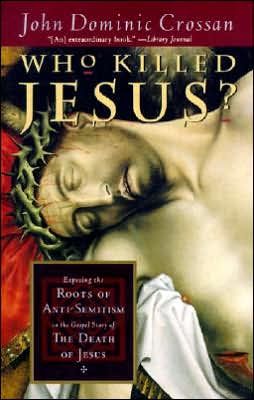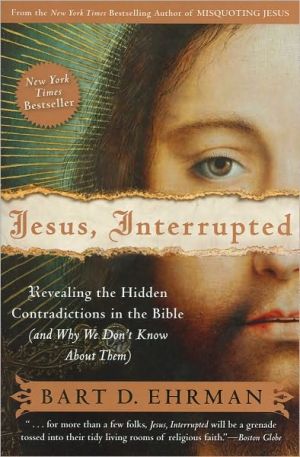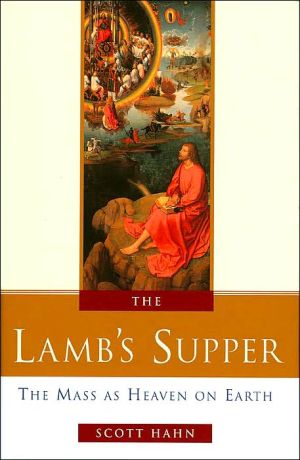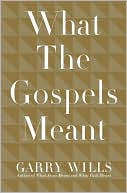Who Killed Jesus?: Exposing the Roots of Anti-Semitism in the Gospel Story of the Death of Jesus
The death of Jesus is one of the most hotly debated questions in Christianity today. In his massive and highly publicized The Death of the Messiah, Raymond Brown — while clearly rejecting anti-Semitism — never questions the essential historicity of the passion stories. Yet it is these stories, in which the Jews decide Jesus' execution, that have fueled centuries of Christian anti-Semitism.\ Now, in his most controversial book, John Dominic Crossan shows that this traditional understanding of...
Search in google:
The death of Jesus is one of the most hotly debated questions in Christianity today. In his massive and highly publicized The Death of the Messiah, Raymond Brown — while clearly rejecting anti-Semitism — never questions the essential historicity of the passion stories. Yet it is these stories, in which the Jews decide Jesus' execution, that have fueled centuries of Christian anti-Semitism. Now, in his most controversial book, John Dominic Crossan shows that this traditional understanding of the Gospels as historical fact is not only wrong but dangerous. Drawing on the best of biblical, anthropological, sociological and historical research, he demonstrates definitively that it was the Roman government that tried and executed Jesus as a social agitator. Crossan also candidly addresses such key theological questions as "Did Jesus die for our sins?" and "Is our faith in vain if there was no bodily resurrection?" Ultimately, however, Crossan's radical reexamination shows that the belief that the Jews killed Jesus is an early Christian myth (directed against rival Jewish groups) that must be eradicated from authentic Christian faith. Arthur Hertzberg Intellectually convincing and brilliantly written. It is essential reading.
Chapter One\ Crime\ In the Territory of Antipas\ Herod the Great ruled the entire Jewish homeland for over thirty years with the tide King of the Jews. After his death, the Roman emperor Augustus divided his territories, placing Galilee and Perea, areas northwest and east of the Jordan, under his son Herod Antipas with the title of tetrarch, and placing Samaria,Judea, and Idumea, areas west and southWest of the Jordan, under a Roman governor with the title of prefect.\ Why did two peasant movements, that of John and that of Jesus, arise in Perea and Galilee rather than in Samaria, Judea, or Idumea? Why did they arise under the Herodian kingling Antipas rather than under his father, Herod the Great, who ruled the entire country from 37 to 4 B.C.E., or under his half-nephew Agrippa 1, who ruled the entire country from 41 to 44 C.E.? And, because Antipas ruled between 4 B.C.E. and 39 C.E., why did they arise in the late 20s rather than in any other period of that long reign? Why did two movements, the Baptism movement of John and the Kingdom movement of Jesus, arise in the late 20S of that first common-era century in the two separated regions of Antipas's territory, John in Perea east of the Jordan and Jesus in Galilee to its northwest? Why precisely there, why exactly then?\ This Land Belongs to God\ The Roman world was an aristocratic society, a preindustrial empire It, which the peasantry produced a very large agricultural surplus. But, as in any agrarian empire, a tiny minority of political and religious elites, along with their supporters and retainers, held the peasantry at subsistence level and thereby obtained levels of luxury thoseexploited and oppressed Peasants could hardly even imagine. The Roman Empire, however, was no longer a traditional but rather a commercialized agrarian empire, and the Jewish peasantry was being pushed into debt and displaced from its holdings at higher than normal rates as land became, under the commercializing Roman economy, less an ancestral inheritance never to be abandoned and more an entrepreneurial commodity rapidly to be exploited. In a traditional or uncommercialized agrarian empire, business or investment intrudes minimally if at all between aristocrats and peasants. There exists almost a steady state situation in which peasants produce and aristocrats take, and it almost looks like an inevitable if not natural process. Peasants resist exploitation, of course, but in the same fatalistic way that they resist other unfortunate but implacable phenomena such as storm, flood, or disease. But with commercialization even the guarantee of owning one's own familial plot of well-taxed land is gone, and the peasantry, having learned that things can change for the worse, begin to ponder how they might also change for the better, even for the ideal or utopian better. As ancient commercialization, let alone modern industrialization, intrudes into an agrarian and aristocratic empire, the barometer of possible political rebellion and/or social revolution rises accordingly among the peasantry. That was. precisely the situation in the Mediterranean world of the first century. The Roman civil wars, from Julius Caesar against Pompey to Octavius against Antony, had ended with Octavius emerging as the victorious Augustus, and this Augustan Peace opened the Roman Empire to an economic boom. But booms do not boom alike for everyone.\ The Jewish peasantry was prone, over and above the resistance expected from any colonial peasantry, to refuse quiet compliance with heavy taxation, subsistence farming, debt impoverishment, and land expropriation. Their traditional ideology of land was enshrined in the ancient scriptural laws. Just as God's people were to rest on the seventh or Sabbath Day, so God's land was to rest on the seventh or Sabbath Year:\ \ For six years you shall sow your land and gather in its yield; but the seventh year you shall let it rest and lie fallow, so that the poor of your people mayeat; and what they leave the wild animals may eat. You shall do the samewith your vineyard, and with your olive orchard. (Exodus 23: 10-11)\ \ \ When you enter the land that I am giving you, the land shall observe a sabbath for the Lord. Six years you shall sow your field, and six years you shall prune your vineyard, and gather in their yield; but in the seventh year there shall be a sabbath of complete rest for the land, a sabbath for the Lord: youshall not sow your field or prune your vineyard. (Leviticus 25:2--4)\ \ On that seventh or Sabbath Year, moreover, Jewish debts were to be remitted and Jewish slaves were to be released.\ \ Every seventh year you shall grant a remission of debts. And this is the manner of the remission: every creditor shall remit the claim that is held against a neighbor, not exacting it of a neighbor who is a member of the community, because the Lord's remission has been Proclaimed. Of a foreigner you may exact it, but you must remit your claim on whatever any member of your community owes yoe . . .\ \ I\ f a member of your community, whether a Hebrew man or a Hebrew woman, is sold to you and works for you six years, in the seventh year you shall set that person free. And when you send a male slave out from you a free person, you shall not send him out empty-handed. Provide liberally out of your flock, your threshing floor, and your wine press, thus giving to him some of the bounty with which the Lord your God has blessed you- (Deuteronomy 15:1-3,12-14)\ \
PrefacePrologue: History and Prophecy1History Remembered and Prophecy Historicized1Dependent and Independent Passion Stories13Anti-Judaism and Anti-Semitism31Ch. 1Crime39In the Territory of Antipas39Peasants in the Temple50Overturning the Tables58Ch. 2Arrest66Prophecies Old and New66A Kiss in Public71Suppliants on the Mount of Olives76Agony as Victory79Ch. 3Trial82In the Beginning Was Psalm 282Bad Memory or Popular Creativity?85Mark's Literary Fingerprints100From One to Two Trials105Other Versions, Other Purposes112Ch. 4Abuse118Scourging and Abuse118Jesus as Scapegoat119Following the Trail of the Reed127Ch. 5Execution133A Thief on Either Side133The Two Thieves as a Test Case137Casting Lots for His Garments141Gall and Vinegar to Drink143Pilate, the Crowd, and the Crucifixion147Ch. 6Burial160Burying the Crucified160Hope Is Not History168The Guards at the Tomb177The Women at the Tomb181Ch. 7Resurrection189According to the Scriptures189The Cross That Spoke195Apparition and Authority202Epilogue: History and Faith211Autobiographical Presuppositions211Theological Presuppositions215Historical Presuppositions218Appendix. The Gospel of Peter223Sources229Index233
\ Susannah HeschelAnyone concerned with the rising tide of anti-Semitism, anyone fascinated by the origins of Christianity, and anyone who likes a good mystery will love this book.\ \ \ \ \ Arthur HertzbergIntellectually convincing and brilliantly written. It is essential reading.\ \ \ Jack T. SandersScholars of early Christianity should not ignore this book merely because of its intended audience. While probably no one will agree with all Crossan's conclusions, he certainly chips away at the two-source theory sufficiently to force everyone to realize that the origins of the canonical Gospels are surely more complicated than we are oftentimes wont to think; and he does score some telling points...\ — Society of Biblical Literature\ \ \ \ \ Jack T. SandersScholars of early Christianity should not ignore this book merely because of its intended audience. While probably no one will agree with all Crossan's conclusions, he certainly chips away at the two-source theory sufficiently to force everyone to realize that the origins of the canonical Gospels are surely more complicated than we are oftentimes wont to think; and he does score some telling points...\ — Society of Biblical Literature\ \








